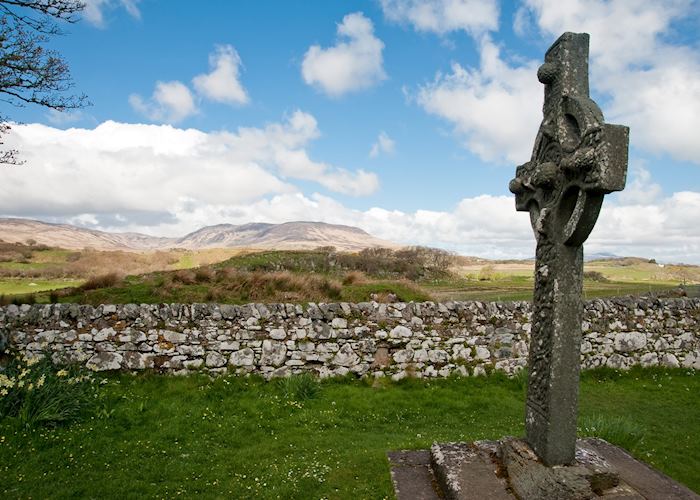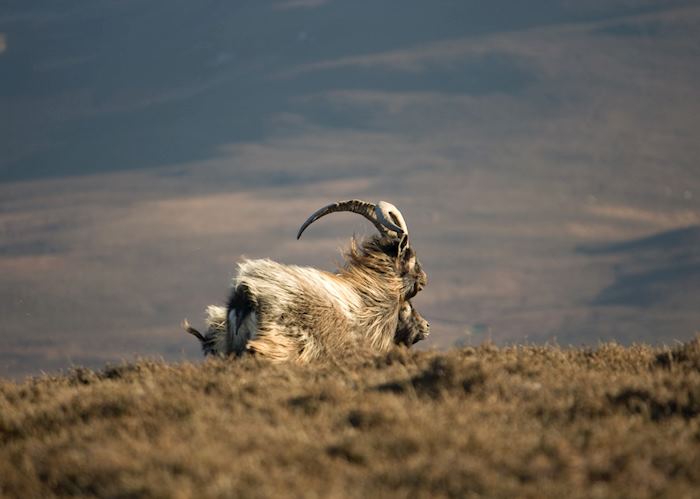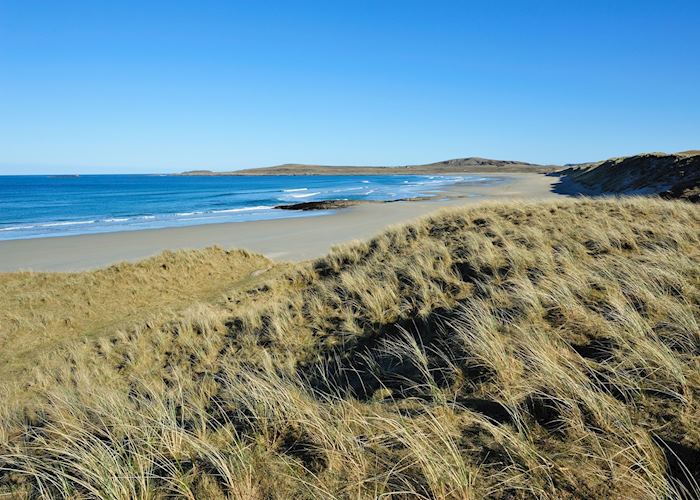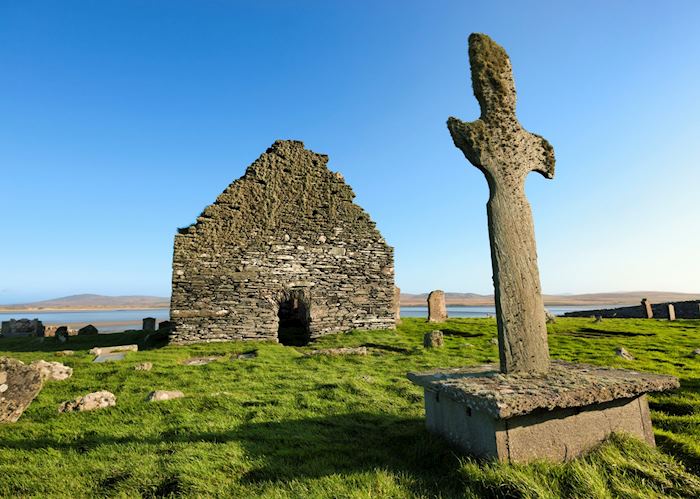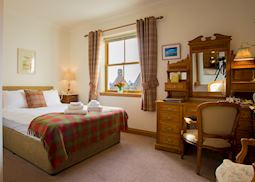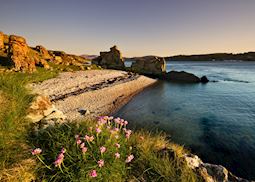Jump to:
Renowned for its peaty whisky, sandy beaches and rich history and wildlife, Islay is easily accessible from mainland Scotland. The island has been inhabited since prehistoric days and is littered with historic remains such as early Christian crosses, medieval ruins and crofters’ cottages.
Most visitors come to see some of the island’s eight whisky distilleries, but while here you can also enjoy the rugged scenery, quiet beaches and great diversity of bird and marine life. Although relatively small, Islay has only two roads and can be slow to get around, but easing into the unhurried pace of island life is one of Islay’s greatest joys.
Things to see and do on the Isle of Islay
Islay’s distilleries
Islay is probably best known for its whisky, and despite its small size, supports eight distilleries. The island’s peaty water and barley contribute to its reputation for producing strongly peaty and smoky whiskies, which are exported around the world.
Three of the best-known distilleries sit on the south coast near Port Ellen, linked by a walkway overlooking the ocean and the islands offshore. Laphroaig, Lagavulin and Ardbeg can all be reached on foot along the path, while Islay’s largest distillery, Caol Ila, faces the Paps of Jura. Bowmore, one of Scotland’s oldest distilleries, sits on Loch Indaal, its maturing warehouse below the water level.
Wildlife on Islay
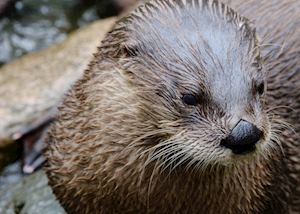 You can spot a wide variety of wildlife in a very compact area when visiting the island. The sea cliffs, bogs, moorland, woods and sandy bays support everything from wild goats and guillemots to gannets and golden eagles. There’s good birdwatching all year round, but particularly in the autumn with the migration of thousands of geese from Greenland.
You can spot a wide variety of wildlife in a very compact area when visiting the island. The sea cliffs, bogs, moorland, woods and sandy bays support everything from wild goats and guillemots to gannets and golden eagles. There’s good birdwatching all year round, but particularly in the autumn with the migration of thousands of geese from Greenland.
You’ll find several seal colonies on the headlands and might even spot otters, dolphins, porpoises or basking sharks from the shore. A wildlife cruise or sea kayaking trip offers good opportunities for spotting seabirds and larger marine life.
American Monument
Overlooking the ocean on the tip of the Oa Peninsula in southwest Islay, the American Monument is a stone tower resembling a lighthouse. It commemorates two ships that were requisitioned for World War I and sunk in 1918.
The SS Tuscania was en route to France with 2,000 soldiers on board when it was torpedoed by a German U-boat in the waters below where the monument now stands. An estimated 230 lives were lost. Eight months later, HMS Otranto collided with another ship during a storm just a few miles away, killing 470 American soldiers and British crew.
You can reach the monument by a pleasant 15-minute walk from a nearby car park, and its position on the tip of the headland offers sweeping views of the coast.
Museum of Islay Life
Set in an old church in Port Charlotte, the Museum of Islay Life traces the history of the island from Mesolithic times. Flint tools dating back to 8,000 BC sit next to Neolithic pottery, Bronze Age burial finds, early Christian carvings and more recent exhibits, such as an illicit whisky still and the bell from the SS Tuscania.
The displays provide a rich overview of how life developed in the region, with examples showing stark contrasts in living conditions between the islanders and the lairds (wealthy landowners) of the Victorian and Edwardian eras. The museum also houses a large collection of books and photographs highlighting local traditions and customs.
Kildalton Cross
Considered one of the finest high crosses in Europe, Kildalton Cross dates to the 8th century and is covered with well-preserved Celtic designs and Christian motifs. The cross stands by a 12th-century church in southeast Islay and is thought to be closely connected to similar crosses on nearby Iona.
It rises just under 3 m (9 ft) high and was carved from a particularly hard chlorite schist, which is resistant to weathering and lichens, leaving it in a remarkable condition. Look for the depictions of Cain and Abel, Abraham and Isaac and the Virgin and Child.
Loch Gruinart Nature Reserve
This protected wood, marsh and moorland in northwest Islay is managed by the Royal Society for the Protection of Birds (RSPB).
Walking trails lead through mudflats, salt marshes and blanket bogs to hides and viewpoints where you can observe lapwings, redshanks, curlews and snipe in spring, summer corncrakes, and the autumn arrival of thousands of Greenland barnacle and white-fronted geese.
You stand to see hen harriers all year round, and you’ll often spot roe deer. The visitor center has displays on all the species found here, and its staff can offer advice on where to walk for the best sightings.
Finlaggan, seat of the Lords of the Isles
An ancient seat of power, tranquil Finlaggan, a few miles from Port Askaig, was the hub of the hugely successful Clan MacDonald between the 13th and 15th centuries. The MacDonalds were known as the Lords of the Isles and controlled the west coast of Scotland, from Kintyre to Lewis.
Loch Finlaggan was their home, and the minimal remains of their fortified tower house and chapel stand on the larger of two islands close to the loch’s north shore. A smaller man-made island nearby was used as a meeting place for their advisors, the Council of the Isles, though archaeological finds suggest it has been inhabited for 5,000 years.
The small visitor center has displays on the history of the clan and their downfall, while a series of information boards explains the significance of the ruins.
Coastal scenery
Although Islay isn’t as wild as the Scottish mainland, its 209 km (130 miles) of indented coastline shelter scenic beaches and coves, caves, waterfalls, shipwrecks and high cliffs. Golden sands and Atlantic rollers make the western beaches ideal for walking, with 12 km (7 miles) of more protected sands along the shoreline between Laggan Point and Kintra.
For more rugged scenery, the Oa Peninsula offers you a variety of walking trails. You’ll also find plenty of options for sailing, sea kayaking and surfing. Sea kayaking trips in particular give you good opportunities to see the coastline from close quarters, approach seal colonies or spot dolphins and porpoises.
Best time to visit Islay
April to October is the best time to visit Islay, when it profits from longer days, warmer, drier weather and more reliable ferry connections. Come in May for the Islay Festival of Music and Malt, or in October to witness the arrival of up to 50,000 Greenland geese.
who's been there
-
617-223-4521617-223-4752
- Make an inquiry
Places near Isle of Islay
- Isle of Jura 28 miles away
- Oban 53 miles away
- Loch Awe 53 miles away
- Loch Lomond 65 miles away
- Glencoe 76 miles away
- Glasgow 78 miles away
- Fort William 84 miles away
- The Highlands 93 miles away
- Isle of Skye 113 miles away
- Edinburgh 119 miles away
- Loch Ness 127 miles away
- The Cairngorms 135 miles away
- St Andrews 139 miles away
- Inverness 141 miles away
- The Outer Hebrides 144 miles away
- The Lake District 155 miles away
- Speyside 164 miles away
- Liverpool 210 miles away
- Snowdonia National Park 221 miles away
- York 241 miles away
- Wales 249 miles away
- Orkney 254 miles away
Photos of Isle of Islay
Accommodation choices for Isle of Islay
We've selected a range of accommodation options for when you visit Isle of Islay. Our choices usually come recommended for their character, facilities and service or location. Our specialists always aim to suggest properties that match your preferences.
-
![Bridgend Hotel]()
Bridgend Hotel
Isle of Islay -
![Islay Hotel]()
Islay Hotel
Isle of Islay -
![Islay House]()
Islay House
Isle of Islay
Ideas for experiencing Isle of Islay
Our specialists seek out authentic ways to get to know the places that could feature in your trip. These activities reflect some of the experiences they've most enjoyed while visiting Isle of Islay, and which use the best local guides.
-
Islay wildlife cruise ![Islay coastline]()
Islay wildlife cruise
Islay wildlife cruise
Spot a wild variety of birdlife, seals, goats and possibly dolphins and basking sharks on this two-hour tour off the coast of Islay. Join a small group for a great introduction to the region, with expert commentary by one of the islanders.
View details -
Islay's whisky & history ![Laphroaig Distillery]()
Islay's whisky & history
Islay's whisky & history
Explore the Isle of Islay in southwest Scotland on a full-day tour that looks into its early-Christian settlements, traditional way of life and long history of whisky making with visits to local sights, museums and distilleries.
View details



